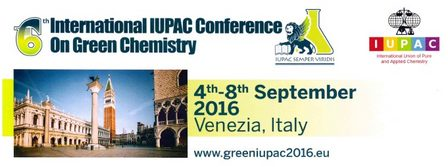Scholars from around the world gather in Venice, Italy, 4-8 September for the 6th International IUPAC Conference on Green Chemistry
 Nearly six hundred scholars from over 70 countries will gather in Venice, Italy from Sunday, 4 September to Thursday, 8 September for the 6th Conference of the International Union of Pure and Applied Chemistry, IUPAC, which is dedicated to green chemistry (ICGC-6). Through the efforts of thousands of scientists around the world, Green Chemistry is emerging with new rules and new strategies for research and development. After Dresden in 2006, Moscow in 2008, Ottawa in 2010, Foz do Iguaçu in 2012, and Durban in 2014, this years’ conference in Venice promises to be particularly rich in new ideas and innovative proposals. Defined as “the invention, design and application of chemical products and processes to reduce or eliminate the use and the production of harmful substances,” Green Chemistry is a basic element of sustainable development that touches many aspects of the environment and human welfare, and relevant to the 17 Sustainable Development Goals set by the United Nations last September.
Nearly six hundred scholars from over 70 countries will gather in Venice, Italy from Sunday, 4 September to Thursday, 8 September for the 6th Conference of the International Union of Pure and Applied Chemistry, IUPAC, which is dedicated to green chemistry (ICGC-6). Through the efforts of thousands of scientists around the world, Green Chemistry is emerging with new rules and new strategies for research and development. After Dresden in 2006, Moscow in 2008, Ottawa in 2010, Foz do Iguaçu in 2012, and Durban in 2014, this years’ conference in Venice promises to be particularly rich in new ideas and innovative proposals. Defined as “the invention, design and application of chemical products and processes to reduce or eliminate the use and the production of harmful substances,” Green Chemistry is a basic element of sustainable development that touches many aspects of the environment and human welfare, and relevant to the 17 Sustainable Development Goals set by the United Nations last September.
The delegates will meet at the Cultural Center Candiani in Mestre Venice. Organized by Professor Pietro Tundo of the University Ca ‘Foscari, the Conference will provide networking opportunities for scientists from around the world to meet and exchange knowledge on Green Chemistry. One challenge for the scientific community is to create cutting-edge technologies that are sustainable in a circular economy where no waste or pollution is produced. Concrete ideas and projects will emerge from the conference and the moral purpose of Green Chemistry will be defined, linking it to peaceful purposes and chemical weapons of mass destruction ban.
The scientific presentations will be divided into five topics: Green Materials, Green Bioprocesses, Green Energy, Green Industrial Processes and Molecular Innovations, and Green Policy, Sustainability, and Safety. The participation of major companies, such as CEFIC (European Chemical Industry Council), CNR (the Italian Consiglio Nazionale delle Ricerche), Riken (Japan), PhosAgro (Russia), Solvay, Merck, L’Oreal, Pirelli, Symrise, SCG Chemicals, Iolitec, Mapei, Hitachi, BASF, ENI, Abbvie Deutschland, Perkin Elmer, Sunrise, will enable the exchange of best practices in the field of industrial production, as well as provide guidelines towards achieving clean and sustainable chemistry. This will have concrete and positive effects on research and technology in Italy and worldwide. The event will also involve the participation of international organizations such as OPCW, the Organization for the Prohibition of Chemical Weapons and UNESCO, the United Nations Educational, Scientific, and Cultural Organization, and set the stage for a special PhosAgro/UNESCO/IUPAC Symposium, featuring the joint Green Chemistry for Life program. The involvement of UNESCO is also of great relevance for the Italian cultural heritage.
The Conference, organized in collaboration with the National Council of Chemists, has the support of seven Italian ministries and other national and international institutions.
The entire program is available on www.greeniupac2016.eu
Conference press room | Facebook | Wikipedia
#greeniupac2016
About IUPAC:
IUPAC was formed in 1919 by chemists from industry and academia. Since then, the Union has succeeded in fostering worldwide communications in the chemical sciences and in uniting academic, industrial and public sector chemistry in a common language. IUPAC is recognized as the world authority on chemical nomenclature, terminology, standardized methods for measurement, atomic weights and many other critically evaluated data. In more recent years, IUPAC has been pro-active in establishing a wide range of conferences and projects designed to promote and stimulate modern developments in chemistry, and also to assist in aspects of chemical education and the public understanding of chemistry. More information about IUPAC and its activities is available at www.iupac.org.
